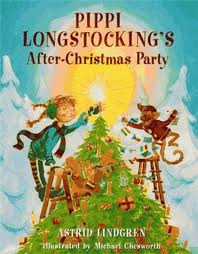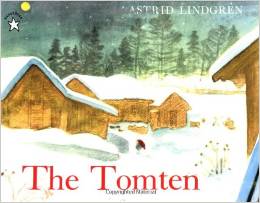The Tomten and the Fox
The Tomten and the Fox is a book I waited for. I waited for two months to get it through a different branch of my county’s library system. It took me five minutes to read. Even taking my time, I don’t think I could stretch this book into more than five minutes. It makes me smile to think of how long I waited vs. how much actual time I needed the book. Yes, it was worth it.
This book is from a poem by Karl-Erik Forsslund but adapted by Astrid Lindgren with pictures by Harald Wiberg, the same illustrator as the original Tomten book.
One thing I found interesting about this book is how in the beginning, there is narration but below the narration there are commands written to the fox, whose name is Reynard. (That’s what I always name my foxes. ) It’s an interesting voice for the book to have – the narrator is telling us a story and communicating with the fox at the same time but separately.
This book has inspired a lot of art. I recommend doing a Google Image search for “Tomten and the Fox” just to see all the crafts that have been created.
My favorite line comes near the end, when the hungry fox has found food and made friends with the Tomten: “It is a night for foxes and tomtens.”
The final picture of the fox walking off into the woods is haunting. Yes, it is a night for foxes and tomtens.

 This is a ridiculously delightful short story. Reading this book totally reaffirmed to myself why I am doing this project. I never would have read it without this project. I’m so glad I did.
This is a ridiculously delightful short story. Reading this book totally reaffirmed to myself why I am doing this project. I never would have read it without this project. I’m so glad I did.
 Brenda Brave Helps Grandmother was published in 1958 as Kajsa Kavat Hjalper Mormor. Pictures are by Ilon Wikland and it was “adapted from the original” by Kay Ware and Lucille Sutherland . . . I’m gonna guess they were the translators? Hard to say for certain. The book I have is from 1961 and translators are often not listed from that era.
Brenda Brave Helps Grandmother was published in 1958 as Kajsa Kavat Hjalper Mormor. Pictures are by Ilon Wikland and it was “adapted from the original” by Kay Ware and Lucille Sutherland . . . I’m gonna guess they were the translators? Hard to say for certain. The book I have is from 1961 and translators are often not listed from that era.
 Lotta’s Christmas Surprise (in Swedish, Visskt kan Lotta nastan allting, 1977) lists no translator. It’s a pleasant Christmas story about Lotta’s family and the tree shortage in town. Lotta and her siblings Jonas and Maria are incredibly upset that they might not have a Christmas tree. In her usual way, Lotta explores the town and happens upon a Christmas tree.
Lotta’s Christmas Surprise (in Swedish, Visskt kan Lotta nastan allting, 1977) lists no translator. It’s a pleasant Christmas story about Lotta’s family and the tree shortage in town. Lotta and her siblings Jonas and Maria are incredibly upset that they might not have a Christmas tree. In her usual way, Lotta explores the town and happens upon a Christmas tree.
 Christmas in the Stable (Jul i Stallet 1961), was illustrated by Harald Wiberg in the version I read, though it appears there have been other illustrators. The layout of the story is interesting, because it is a story of a mother telling her daughter a story about Christmas. We never even learn the child’s name; in fact she barely appears in the story. Lindgren has employed this story-within-a-story technique before (Ghost of Skinny Jack comes to mind), but it’s particularly well-done here. Instead of being just another story about Christmas, it has become a story about someone telling a story about Christmas.
Christmas in the Stable (Jul i Stallet 1961), was illustrated by Harald Wiberg in the version I read, though it appears there have been other illustrators. The layout of the story is interesting, because it is a story of a mother telling her daughter a story about Christmas. We never even learn the child’s name; in fact she barely appears in the story. Lindgren has employed this story-within-a-story technique before (Ghost of Skinny Jack comes to mind), but it’s particularly well-done here. Instead of being just another story about Christmas, it has become a story about someone telling a story about Christmas.
 My second visit to Noisy Village was much less daunting than the first one. This book is again narrated by Lisa, but she never introduces herself in the book. I think this is an interesting choice – perhaps it helps immerse the reader by making us become the narrator. This time around, with a general idea of the characters, it was much easier to lose myself in the story and not get hung up on who’s who. Luckily for me, Ilon Wikland, the illustrator for Springtime in Noisy Village, also illustrated this book. I try not to focus too much on the illustrations or illustrators, focusing instead on the story, but Ilon’s sense of humor and continuity is definitely important.
My second visit to Noisy Village was much less daunting than the first one. This book is again narrated by Lisa, but she never introduces herself in the book. I think this is an interesting choice – perhaps it helps immerse the reader by making us become the narrator. This time around, with a general idea of the characters, it was much easier to lose myself in the story and not get hung up on who’s who. Luckily for me, Ilon Wikland, the illustrator for Springtime in Noisy Village, also illustrated this book. I try not to focus too much on the illustrations or illustrators, focusing instead on the story, but Ilon’s sense of humor and continuity is definitely important.